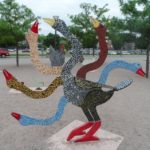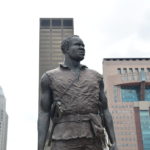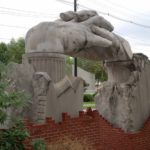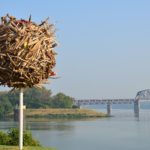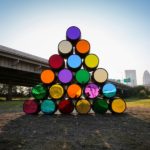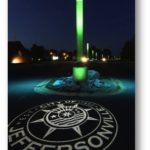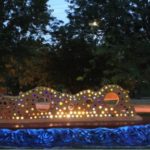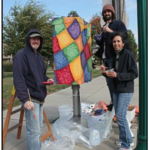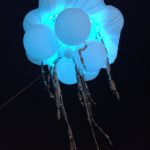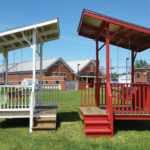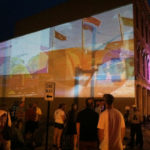Anyone interested in having an art experience will have no problem finding some in Metro Louisville, including Southern Indiana. Just walk outside and a vibrant collection of public art is in plain sight.
Louisville is a city committed to art and making art accessible to its citizens. Public art is one way this happens. Take a simple stroll on a downtown street, and you are likely to encounter some kind of artwork from a sculpture, to a bust, to sometimes frowned upon but equally important street art.
Throughout the city, large sculptural pieces stand along the sidewalks, waterways, in parks and in front of most major public buildings. Some of the works date back to and honor the founding of the city. Many pieces were created by world-renowned sculptors like Alexander Calder, Tony Smith, Barney Bright, and Ed Hamilton.
There are murals, installations, and paintings on view in public buildings, alleys and public spaces like the Louisville’s waterfront Belvedere, which is home to the “York” sculpture by Ed Hamilton. The statue was commissioned in honor of the Falls of the Ohio Bicentennial Celebration of Lewis and Clark’s expedition. York was a slave who participated in Lewis and Clark’s historic expedition.
Keep walking along Waterfront Park and on the corner of Witherspoon and Preston Streets, you’ll see MeGoosa, one of 28 bird sculptures forming the “Flock of Finns” installation. This whimsical installation was based on wooden originals created by Louisville artist Marvin Finn. The original designs were enlarged and fabricated in steel then painted in Finn’s style by artist Melissa Wilson.
Head West to the Nia Center (2900 West Broadway), and you’ll be greeted by two monumental Indiana Limestone hands, one representing the community, the other representing the Nia Center. These hands join together to create Don Lawler and Meg White’s massive “Opportunity Portal.”
Handling Public Art, Upcoming Projects
If it seems like public art is becoming more apparent. You are correct. The Commission on Public Art (COPA) was established in 2010 to oversee the implementation of the Louisville Public Art Master Plan, advocate for public art throughout Louisville, as well as, review and develop plans for the inventory, maintenance, acquisition, and deaccession of public art owned by Louisville Metro.
One of the results of the Louisville Public Art Master Plan was The Public Arts Initiative, which is part of Louisville Forward. In 2014, the city hired Sara Lindgren as Louisville’s Public Arts Administer. Prior, Lindgren worked with the Speed Art Museum and St. Louis Art Museum. In addition to making sure the city has a record of its art, Lindgren works on cultivating new public art projects. She works with artists both local and beyond to develop projects that work with the Louisville Forward model.
Connect|Disconnect was the inaugural project of Louisville Metro Government’s Public Art Initiative and the COPA. Connect|Disconnect brought together the creations of five acclaimed artist teams commissioned for the project. Their art was displayed between 8th and 12th Streets in West Downtown/East Portland areas of the city.
One upcoming project, The Louisville Knot, is being developed to connect Louisville at the Ninth Street divide, or the cities imaginary and historical east/west dividing line. This project is being led by Interface Studio Architects, a design team from Philadelphia. The local team at Core Design is fabricating the knot.
SoIn Pursues Public Art
Louisville is not alone in pursuing public art initiatives. Following Louisville’s model, public art initiatives have carried over the other major “diving line,” the Ohio River, into Southern Indiana.
Going north, just over one of the four downtown bridges, from Louisville, Southern Indiana works to keep up the pace with the creative boom that’s happening in the River City. Two Southern Indiana cities, in particular, are bringing their communities into the modern creative age— Jeffersonville, with its public art endeavors spearheaded by Dawn Spyker, and New Albany with strong art shows and public art events heralded by the Carnegie Center for Art and History and, led by the curatorial eye of Daniel Pfalzgraf.
Spyker became the Public Arts Coordinator for Jeffersonville three years ago after spending 11 years as an art teacher at Jeffersonville High School. She was first asked to volunteer as an art commissioner and then was hired as the person to help Jeffersonville produce and acquire public art.
In Jeffersonville, the city owns 63 public works, and Spyker is working towards adding to that collection with some works that could include donations from members of the public and businesses.
“I’m kind of teaching the city to come into its own with creativity and how to appreciate it within the city,” Spyker says. “At first it raised a lot of eyebrows and now it’s become expected.”
Art Engagement in New Albany
In New Albany, Pfalzgraf, who spent the better part of 18 years working in galleries around Louisville, New Albany, and Atlanta, knows that public art isn’t always the easiest road to traverse with the public, but the value is priceless.
“Many people never step foot in a museum or gallery,” he says. “The participation and enjoyment of art engagement is something that everyone should benefit from, and shouldn’t be reserved only for those who have certain economic or educational advantages.”
Much of the public art in New Albany is temporary. The few exceptions include the Barney Bright sculpture, “The Search,” at the New Albany-Floyd County Public Library on Spring Street and a new public skate park venture called the New Albany Flow Park. It will be a “skate-able work of public art.”
Each year New Albany hosts a family-friendly public art event called “I AM Public Art.” This year the event was held on September 23, 2017.
Creative Communities mean healthy communities. With the interest and involvement of the community in creative endeavors at an all-time high, the trend towards accessible and public artwork will only continue.

